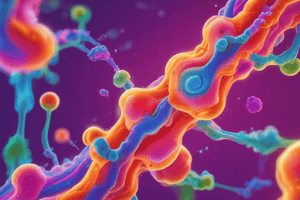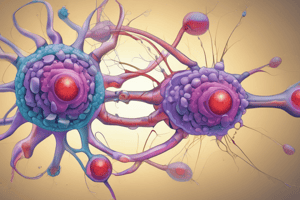Podcast
Questions and Answers
Which type of receptor is involved when insulin binds to a cell to facilitate glucose entry?
Which type of receptor is involved when insulin binds to a cell to facilitate glucose entry?
- Ligand-gated ion channels
- Enzyme-linked receptors (correct)
- G-protein-coupled receptors
- Intracellular receptors
G-protein-coupled receptors are involved in stress responses, such as the release of epinephrine.
G-protein-coupled receptors are involved in stress responses, such as the release of epinephrine.
True (A)
What signaling molecule is involved in the stress response to increase glucose availability from glycogen?
What signaling molecule is involved in the stress response to increase glucose availability from glycogen?
Epinephrine
Insulin is secreted by _____ cells when glucose levels increase.
Insulin is secreted by _____ cells when glucose levels increase.
Match the following receptors with their functions:
Match the following receptors with their functions:
Which ligand binds to intercellular receptors to stimulate the conversion of amino acids to glucose?
Which ligand binds to intercellular receptors to stimulate the conversion of amino acids to glucose?
Insulin signals the cell to release glucose into the bloodstream for energy production.
Insulin signals the cell to release glucose into the bloodstream for energy production.
What type of receptors do neurotransmitters bind to on muscle cells?
What type of receptors do neurotransmitters bind to on muscle cells?
Epinephrine binds to ___________________ to signal the breakdown of glycogen.
Epinephrine binds to ___________________ to signal the breakdown of glycogen.
Match the hormone with its corresponding receptor type:
Match the hormone with its corresponding receptor type:
What is one reason cells need to respond to signals?
What is one reason cells need to respond to signals?
Explain the function of nonpolar ligands in cellular communication.
Explain the function of nonpolar ligands in cellular communication.
What are the three common stages of cell signaling?
What are the three common stages of cell signaling?
All living organisms require cell communication to survive.
All living organisms require cell communication to survive.
What is the role of ligands in cell signaling?
What is the role of ligands in cell signaling?
Cells detect and respond to signals from their ______ and from other cells.
Cells detect and respond to signals from their ______ and from other cells.
Match the following components of cell signaling with their functions:
Match the following components of cell signaling with their functions:
Which of the following can be considered a signal in cell communication?
Which of the following can be considered a signal in cell communication?
Signal transduction occurs exclusively within the same cell.
Signal transduction occurs exclusively within the same cell.
Why is cell communication critical for multicellular organisms?
Why is cell communication critical for multicellular organisms?
The process of ______ involves a group of proteins forming a signaling pathway in signal transduction.
The process of ______ involves a group of proteins forming a signaling pathway in signal transduction.
What is the Kd value indicative of?
What is the Kd value indicative of?
A ligand-binding changes the receptor structure and transmits the signal across the membrane.
A ligand-binding changes the receptor structure and transmits the signal across the membrane.
What happens to the receptor after the ligand is released?
What happens to the receptor after the ligand is released?
Kd can also be considered the 'minimum effective dose' of ligand needed to __________.
Kd can also be considered the 'minimum effective dose' of ligand needed to __________.
Match the following terms with their definitions:
Match the following terms with their definitions:
Which of the following best describes high affinity ligands?
Which of the following best describes high affinity ligands?
At equilibrium, Kd is equal to koff divided by kon.
At equilibrium, Kd is equal to koff divided by kon.
What is the significance of the ligand-receptor complex's stability?
What is the significance of the ligand-receptor complex's stability?
The complex that forms between the ligand and its receptor is __________ for a finite period of time.
The complex that forms between the ligand and its receptor is __________ for a finite period of time.
Flashcards
Cell Surface Receptors
Cell Surface Receptors
Receptor proteins on the cell surface that bind to signaling molecules, initiating a chain of events inside the cell.
Enzyme-linked Receptors
Enzyme-linked Receptors
A type of cell surface receptor that activates an enzyme within the cell upon binding to a signaling molecule.
G-protein-coupled Receptors
G-protein-coupled Receptors
A type of cell surface receptor that uses a G-protein to relay signals to other proteins within the cell.
Ligand-gated Ion Channels
Ligand-gated Ion Channels
Signup and view all the flashcards
Cell Signaling
Cell Signaling
Signup and view all the flashcards
Ligand
Ligand
Signup and view all the flashcards
Receptor
Receptor
Signup and view all the flashcards
Intracellular receptors
Intracellular receptors
Signup and view all the flashcards
Signaling Molecule (Ligand)
Signaling Molecule (Ligand)
Signup and view all the flashcards
Receptor Activation
Receptor Activation
Signup and view all the flashcards
Signal Transduction
Signal Transduction
Signup and view all the flashcards
Cellular Response
Cellular Response
Signup and view all the flashcards
Signal Transduction Pathway
Signal Transduction Pathway
Signup and view all the flashcards
Why is Cell Communication Necessary?
Why is Cell Communication Necessary?
Signup and view all the flashcards
How do Cells Communicate?
How do Cells Communicate?
Signup and view all the flashcards
Receptor Affinity
Receptor Affinity
Signup and view all the flashcards
Ligand-Receptor Complex
Ligand-Receptor Complex
Signup and view all the flashcards
On-Rate (kon)
On-Rate (kon)
Signup and view all the flashcards
Off-Rate (koff)
Off-Rate (koff)
Signup and view all the flashcards
Dissociation Constant (Kd)
Dissociation Constant (Kd)
Signup and view all the flashcards
Minimum Effective Dose
Minimum Effective Dose
Signup and view all the flashcards
Study Notes
Cell Communication
- Cells communicate to survive
- Communication involves responding to incoming signals and sending outgoing signals
- Signals can be chemical molecules or physical parameters like light or temperature
- Cell communication is necessary for responding to a changing environment
Cell Signaling
- A 3-step process
- Receptor activation: A signaling molecule binds to a receptor causing a conformational change.
- Signal transduction: The activated receptor initiates a series of proteins that form a signal transduction pathway.
- Cellular response: The pathway affects cellular functions or protein amounts to produce a specific response.
Receptor Activation
- Ligands (signaling molecules) bind to receptors with high specificity
- Ligand binding changes the receptor structure, transmitting the signal
- Once the ligand is released, the receptor reverts to its inactive form
Receptor Affinity
- Affinity is measured by the dissociation constant (Kd)
- Kd is the concentration of ligand needed for 50% of receptors to be bound
- A lower Kd means higher affinity
Cell Surface Receptors
- Most signaling molecules are small and hydrophilic or too large to pass through the plasma membrane
- Cell surface receptors are embedded in the plasma membrane and detect extracellular signals
- Three types of receptors
- Enzyme-linked receptors
- G-protein-coupled receptors
- Ligand-gated ion channels
Enzyme-linked receptors
- Have two domains: extracellular signal-binding and intracellular catalytic
- They function as protein kinases.
- They transfer a phosphate group from ATP to specific amino acids in target proteins to change protein shape and function.
G-protein-coupled receptors (GPCRs)
- Interact with intracellular G proteins
- Receptor activation causes the G protein's a subunit and βγ dimer to dissociate. Subunits then interact with other proteins.
Ligand-gated ion channels
- When a signaling molecule binds, the channel opens, allowing ion flow across the membrane.
Intracellular Receptors
- Found in the cytosol or nucleus
- Bind small, hydrophobic signaling molecules that can diffuse across the plasma membrane.
- Activation leads to a change in gene expression, typically via a change in transcription factor activity.
- Steroid hormones like estrogen use these receptors.
Studying That Suits You
Use AI to generate personalized quizzes and flashcards to suit your learning preferences.



